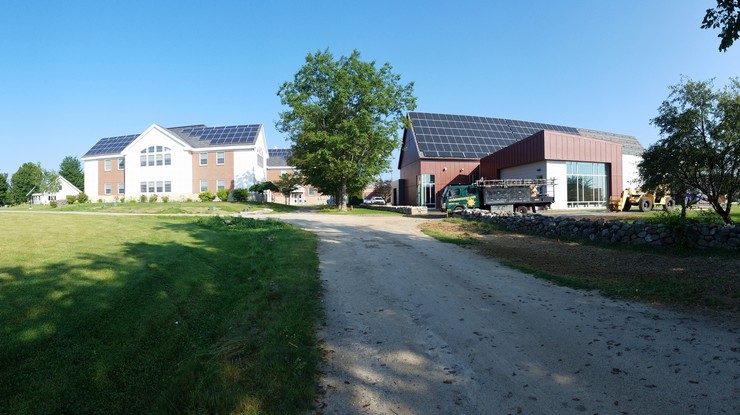
ReVision Energy installed a 68.4-kilowatt solar array on the roof of Colby-Sawyer College’s new Center for Art + Design. Photo courtesy of ReVision Energy
By George Harvey
Readers of Green Energy Times (GET) should recognize Colby-Sawyer College as a long-time mover on renewable energy and climate change. GET has published articles on things going on at the college frequently.
In December, 2014, GET published “Innovative NetZero Classroom Is Built by Colby-Sawyer Students” (http://bit.ly/CS-sunshack), about the first commercial building in New Hampshire to incorporate straw bales in its construction, the Sunshack. This building was designed and built by students. In February, 2016, GET published “Colby-Sawyer College Announces Three-Year Degree in Community-Based Sustainability” (http://bit.ly/CS-sustainability-course). In the same issue, another article, “A Vision for a Permaculture City,” covered efforts by Franklin, New Hampshire, and listed Colby-Sawyer College as one of the city’s collaborators (http://bit.ly/Franklin-permaculture-city). And in April 2017, another article appeared, “Colby-Sawyer College Students Partner with PermaCityLife to Support Franklin’s Revitalization Efforts” (http://bit.ly/CS-students-partner).
Clearly, Colby-Sawyer is a leading green college, so the next update on the work underway at Colby-Sawyer comes as no surprise. ReVision Energy installed a 68.4-kilowatt (kW) solar array in July.
The new installation is on the roof of the new Center for Art + Design. The 15,000 square foot building is opening this fall, with studios, theater, a fine art galleria, outdoor art areas, and offices.
The solar array includes 228 Q Cells 300-watt solar panels. It has four SolarEdge inverters to change the DC current from the array into the AC current used in the building. It also is equipped to allow college operators to track its performance with computers.
The array on the on the roof of the college’s new Center for Art + Design is expected to produce a little over 80,000 kilowatt hours (kWh) of electricity each year. This is sufficient to offset nearly 83,000 pounds of carbon dioxide emissions annually. That amount would be emitted by burning a little over 4,200 gallons of gasoline. It is the amount one would save by allowing 36 acres of forest to grow to sequester carbon.
Jennifer White ‘90, who is Colby-Sawyer’s Director of Sustainability, said, “We are excited about this additional solar array as it enables Colby-Sawyer to expand its commitment to sustainability and renewable energy while allowing us to gain internal control of a portion of our energy budget moving forward.”
The solar system on the art and design center was installed at no upfront cost to the college and is owned by IGS Solar. The college is buying the power from IGS through a power purchase agreement (PPA). Under the terms of the agreement, the college will buy the power at a negotiated rate for seven years. At that time, the college will have the option to purchase the system at a significant discount, after which it would have projected savings of about $6,000 per year for the life of the array. Though the array is warranted for 25 years, it is expected to last about 40, so the savings over a 33-year term of ownership could approach $200,000.
This is not the first time Colby-Sawyer has installed solar systems under a PPA. Four buildings had rooftop systems installed in a 127-kW project financed by ReVision Energy under similar terms. That older system generates about 152,000 kWh of electricity per year.
Colby-Sawyer Collage has a goal of carbon neutrality by 2050, under a carbon action plan adopted by the board of trustees in 2010. Goals have included a 50% reduction in carbon emissions by 2015 and a 70% reduction by 2020. The college has been purchasing renewable energy credits under this policy. It sees purchase of the credits as a stepping stone to an integrated long-term approach to carbon emissions. Additions of solar power on the campus, along with efficiencies and other actions, work to achieve that long-term goal.








Leave a Reply